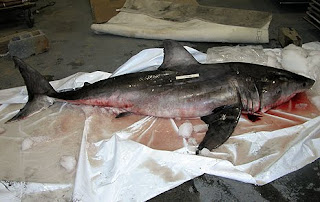Considering the incredible number of between 150 - 200 million sharks destroyed each year, we need to look at the natural biology of sharks to fully understand the potential threat of extinction to these species. Most sharks are slow growing, have late maturation and low fecundity and this is the shark's downfall. They cannot replace their stocks to keep up with human exploitation, such as say, sardines can. Lets look at the Great White Shark. The Great White Shark female takes approximately 15 years to become sexually mature, and the male about 8 years. At these ages the female will be around five meters long and the male around four meters long. The Great White Sharks' fecundity is low, so the female may possibly only give birth to several litters of pups in a lifetime and these litters are relatively small, ranging from about seven to eleven pups in a litter. The white shark is just an example, and if you look at all species, you find some which give birth to only one pup and some such as the Sandbar shark which only become sexually mature at about 25 years old. So due to the shark's inability to reproduce quickly, stock replacement is not occurring, and subsequently the populations of the world are fast diminishing. In fact they are being wiped out far quicker than most people realise, with many species critically endangered and some species literally on the brink of extinction.
The Great White Shark is now protected in South Africa, California, South Australia and Tasmania, and although this is only one of almost 400 species of shark, its protection is a step in the right direction. The Great White is a key stone species on this planet and its protection, subsequent media attention and high public profile allows us to use it as a battering ram to push for the protection of other shark species.








